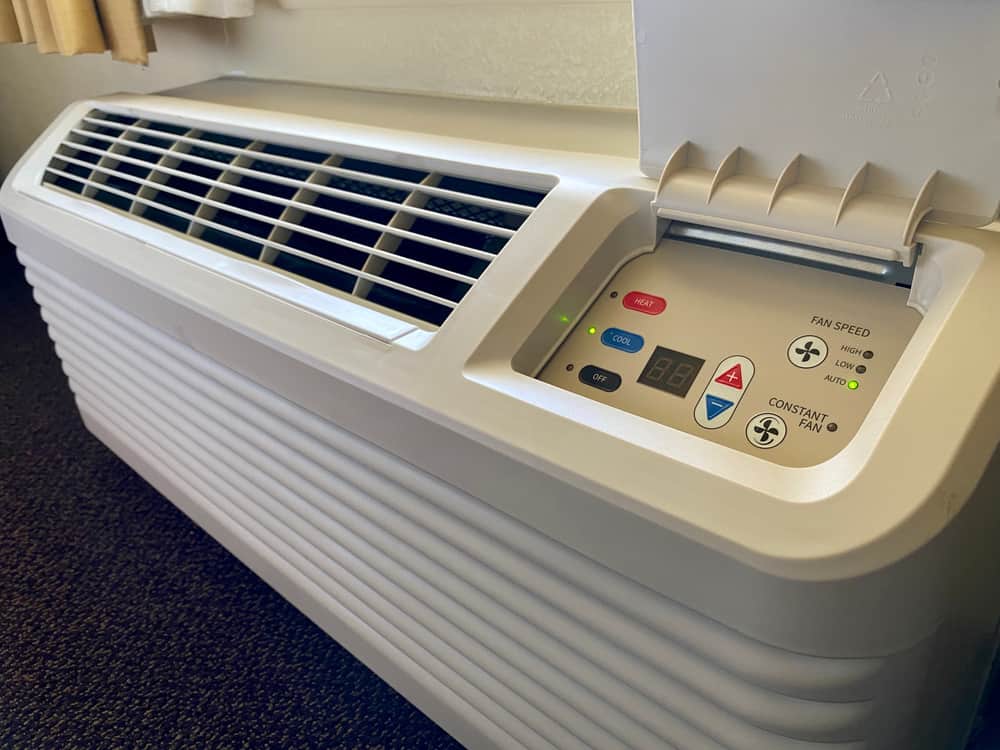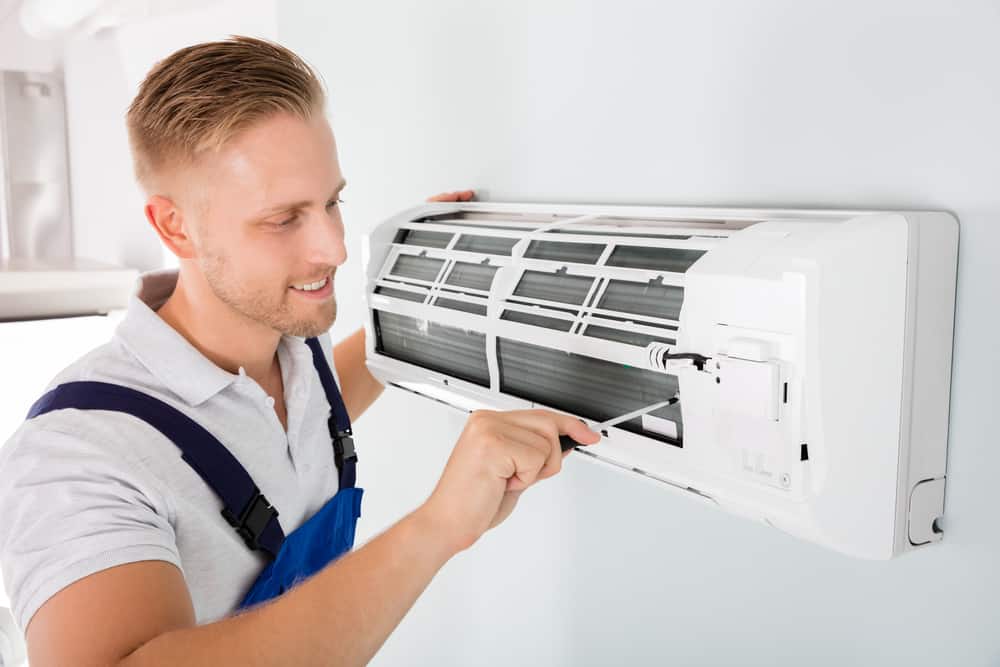Summary:
What Is a PTAC System and How Does It Work
A PTAC system—short for Packaged Terminal Air Conditioner—is essentially a self-contained heating and cooling unit that mounts through your exterior wall. Think of it as a more sophisticated cousin of the window AC unit, but designed for permanent installation and year-round comfort.
Unlike those shared heating systems that leave you at the mercy of your building’s boiler schedule, a PTAC gives you complete control over your space. The unit pulls in outside air for ventilation while using electricity to run a refrigerant system that can both cool and heat your room. Most units also connect to your building’s hot water system for additional heating power during those brutal New York winters.
Why PTAC Systems Beat Traditional NYC Apartment Heating
If you’ve lived in Queens long enough, you know the frustration of NYC’s old heating systems. Over 80% of large apartment buildings still rely on steam heating that was installed around the 1918 flu pandemic. These systems pump heat through the entire building whether you want it or not.
The result? You’re opening windows in January because your apartment feels like a tropical greenhouse, then shivering in March when the heat randomly shuts off. Your energy bills stay high because you’re paying to heat spaces you’re not even using, and you have zero control over when that heat kicks in.
PTAC systems flip this script entirely. You get individual room control that lets you set one room to 68 degrees for sleeping while keeping your living area at 74 degrees for comfort. No more being held hostage by a building-wide thermostat that someone else controls. The system only heats or cools the space you’re actually using, which can cut your energy costs significantly compared to trying to battle an overactive radiator system.
Plus, these units provide consistent temperature control instead of the wild swings you get with steam heat that cycles on and off unpredictably. Your comfort level stays steady instead of bouncing between “arctic tundra” and “tropical rainforest” throughout the day.
The Energy Efficiency Advantage for Queens Residents
Here’s something that might surprise you: ductwork can account for up to 40% of energy losses in traditional HVAC systems. Since PTAC systems don’t need ducts, you’re immediately more efficient than buildings that rely on central air distribution.
When you’re only conditioning the space you’re actually using, instead of trying to heat or cool an entire apartment when you’re only in one room, the energy savings add up fast. This is especially important in Queens where many apartments have unusual layouts or rooms that don’t get used regularly.
The newer PTAC models also come with programmable thermostats and energy management features. You can set the system to automatically adjust when you’re not home, or even control it remotely through smart home integration. Some units can detect occupancy and adjust accordingly, so you’re not wasting energy cooling an empty bedroom all day.
For apartment dwellers who are tired of high utility bills with little control over their comfort, PTAC systems offer a way to take charge of both your energy usage and your living environment. You pay for what you use, when you use it, instead of subsidizing heat for the entire building.
PTAC Systems vs Other Cooling Options for NYC Apartments
When summer hits Queens, your cooling options usually feel pretty limited. Window units are the most common choice, but they block your view, take up valuable window space, and can be noisy eyesores that stick out of your building’s facade. Some buildings don’t even allow them, especially in landmarked areas.
Through-the-wall units offer a cleaner look, but they’re typically cooling-only and require separate heating solutions. Mini-split systems provide excellent efficiency and quiet operation, but they come with higher upfront costs and need professional installation of both indoor and outdoor components.
PTAC systems hit the sweet spot between functionality and practicality for most Queens apartment situations.
Installation and Maintenance Reality Check
One of the biggest advantages of PTAC systems is their straightforward installation process. Once you have the wall sleeve installed—which is typically a one-time job—replacing or upgrading units becomes incredibly simple. The new unit literally slides into place and plugs in, with no complex refrigerant work or multiple components to coordinate.
This is a huge advantage in NYC where getting contractors into your building can be a logistical nightmare. When your unit needs service or replacement, you’re not dealing with outdoor condenser units, refrigerant lines running through your walls, or coordinating multiple installation teams.
The maintenance is also more straightforward than other systems. Most PTAC units just need regular filter cleaning and annual professional servicing to keep running efficiently. Since everything is contained in one unit, troubleshooting problems is simpler, and parts are standardized across most manufacturers.
For Queens residents who want reliable climate control without the hassle of complex installations or maintenance headaches, PTAC systems deliver exactly what you need. You get professional-grade heating and cooling that doesn’t require you to become an HVAC expert or deal with multiple service calls when something goes wrong.
Cost Considerations and Long-Term Value
Let’s talk numbers. PTAC systems typically cost more upfront than basic window units, but they’re generally less expensive than installing mini-split systems throughout your apartment. The real value comes from the long-term energy savings and the convenience of year-round climate control in one unit.
When you factor in the cost of running separate heating and cooling systems, plus the energy waste from poor temperature control in typical NYC apartments, PTAC systems often pay for themselves within a few years. You’re also avoiding the ongoing costs of replacing window units every few years or dealing with the maintenance headaches of older heating systems.
The installation costs are also more predictable since you’re working with standardized wall sleeves and straightforward electrical connections. There are no surprises about running new electrical lines or structural modifications that can pop up with other systems.
For apartment dwellers who plan to stay in their Queens location for more than a couple of years, PTAC systems represent a smart investment in comfort and energy efficiency. You get immediate improvement in your living situation plus long-term savings on your utility bills.
Making the Right Choice for Your Queens Apartment
PTAC systems aren’t perfect for every situation, but they solve the most common climate control problems that Queens apartment dwellers face. You get individual room control, year-round comfort, energy efficiency, and straightforward maintenance in one package.
The key is working with experienced professionals who understand both PTAC technology and the unique challenges of NYC apartment installations. You want contractors who can properly assess your space, recommend the right capacity unit, and handle the installation without creating problems for your building management.
If you’re ready to take control of your apartment’s comfort instead of being at the mercy of building-wide systems, we at Lion-Air Enterprises have the expertise to help you find the right PTAC solution for your specific needs.



